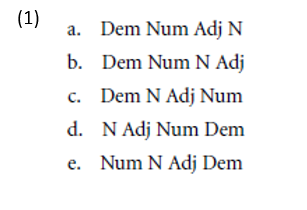


 Grammar
Grammar
 Tenses
Tenses
 Present
Present
 Past
Past
 Future
Future
 Parts Of Speech
Parts Of Speech
 Nouns
Nouns
 Verbs
Verbs
 Adverbs
Adverbs
 Adjectives
Adjectives
 Pronouns
Pronouns
 Pre Position
Pre Position
 Preposition by function
Preposition by function 
 Preposition by construction
Preposition by construction
 Conjunctions
Conjunctions
 Interjections
Interjections
 Grammar Rules
Grammar Rules
 Linguistics
Linguistics
 Semantics
Semantics
 Pragmatics
Pragmatics
 Reading Comprehension
Reading Comprehension|
Read More
Date: 2024-01-23
Date: 4-8-2021
Date: 9-3-2022
|
Universal 20 of Greenberg
Greenber’s (1963) Universal 20 is stated as follows:
Universal 20: When any or all of the elements (demonstrative, numeral, and descriptive adjective) precede the noun, they are always found in that order. If they follow, the order is either the same or its exact opposite.
Subsequent work has confirmed the essentials of this observation (Hawkins 1983; Dryer 1992; Cinque 2005), though the order N–Dem–Num–A turns out not to be terribly common. The most common orders are apparently the following (judging from Hawkins 1983; Cinque 2005; and searches in the World Atlas of Linguistic Structures, Haspelmath et al. 2005):

The most common orders are N-initial and N-final ones (273 languages in Haspelmath et al. 2005 have N preceding all of Dem, Num, and Adj, while another 191 have N following all three). The other three orders listed in (1) are about equally common (between fifty and seventy-five languages each in Haspelmath et al. 2005). No other orders are at all common.1
If we take as the null hypothesis that the most common order of phrasal elements directly reflects the underlying universal hierarchy, the hierarchy is Dem > Num > Adj > N. The order in (1b) is simply derived by moving N to the left of Adj. The order in (1c) is derived by combining that step with an additional step moving the [N–Adj] sequence across Num. And the order in (1d) involves yet another step, moving [[N–Adj]–Num] across Dem. Cinque (2005) notes that N-raising orders are all attested, for example Dem–N–Num– A, in which the N moves across the Num and A.
1 Haspelmath et al. (2005) give the relative order of the noun and each dependent; thus, it can be determined, for example, that sixty-nine languages have Numeral before Noun, and Noun before both Adjective and Demonstrative; the database itself does not indicate how many of these sixty-nine are Num-N-Adj-Dem and how many are Num-N-Dem-Adj. Independent investigation shows that the former is much more common than the latter. See for example Hawkins (1983: 119), who lists seven Num-N-Adj-Dem languages and no Num-N-Dem-Adj ones. For a detailed analysis of this order in Semitic languages see Shlonsky (2004).
|
|
|
|
للعاملين في الليل.. حيلة صحية تجنبكم خطر هذا النوع من العمل
|
|
|
|
|
|
|
"ناسا" تحتفي برائد الفضاء السوفياتي يوري غاغارين
|
|
|
|
|
|
|
ملاكات العتبة العباسية المقدسة تُنهي أعمال غسل حرم مرقد أبي الفضل العباس (عليه السلام) وفرشه
|
|
|